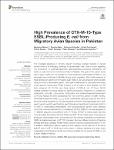High Prevalence of CTX-M-15-Type ESBL-Producing E. coli from Migratory Avian Species in Pakistan
Mohsin, Mashkoor
Raza, Shahbaz
Schaufler, Katharina
Roschanski, Nicole
Sarwar, Fatima
Semmler, Torsten
Schierack, Peter
Guenther, Sebastian
The increased presence of clinically relevant multidrug resistant bacteria in natural environments is an emerging challenge for global health care. Little is known regarding the occurrence of extended-spectrum beta-lactamase producing Escherichia coli (ESBL-E. coli) from environmental sentinels in Pakistan. The goal of the current study was to gain insights into the prevalence and phylogenetic relationships of ESBL-E. coli recovered from wild birds in Pakistan during winter migration. After initial screening of fecal samples on selective chromogenic agar, ESBL-E.coli were analyzed phenotypically using the Vitek-2 automated system. Genotypic characterization was performed using whole genome sequencing (WGS) followed by an in-depth in silico analysis. Of 150 birds screened, 26 (17.3%) were fecal carriers of ESBL-E. coli. Of these, 88.4% isolates exhibited multidrug resistance (MDR) phenotypes. Resistance to cefotaxime, ceftazidime, ampicillin, doxycycline, tetracycline and sulfamethoxazole/trimethoprim (CTX-CAZ-AM-DC-TE-SXT) represented the most common pattern of MDR (76.9%). WGS data analysis found blaCTX-M-15 as the predominant ESBL genotype (92.3%). Other genes encoding resistance to sulfonamides (sul1/sul2/sul3), aminoglycosides (strA, strB, aadA1, aadA2, aadA5, aac(3)-IId-like, aac(3)-IVa-like and aph(4)-Ia), trimethoprim (dfrA14 or dfrA17), tetracyclines [tet(A)/tet(B)], and fluoroquinolones (qnrS1) were detected commonly, often encoded on IncF-type plasmids (76.9%). ESBL-E. coli were assigned to 17 different sequence types (STs) of which ST10 and ST7097 (4 isolates each) were the most abundant followed by ST4720, ST93, and ST1139 (2 isolates each). Core-genome phylogeny of the isolates found low numbers (0–29) of single nucleotide polymorphisms (SNPs) in isolates belonged to ST7097 originated from two different locations (Chashma barrage and Rasul barrage). Similar trends were found among isolates belong to ST1139. In addition, WGS-based plasmid typing and S1-digestion found plasmids of the same pMLST type (IncF[F-:A-:B53]) and similar sizes in different bacterial and avian hosts suggesting horizontal gene transfer as another possibility for the spread of ESBL-E. coli in avian wildlife in Pakistan.
Dateien zu dieser Publikation
Keine Lizenzangabe

